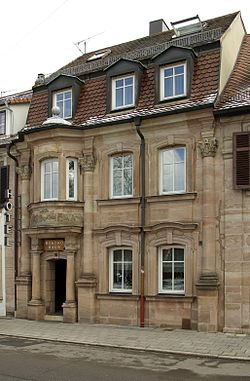Rococo House (Erlangen)
| Rococo house | |
|---|---|
 The Rococo House, 2013 |
|
| Data | |
| place | Erlangen , Bavaria |
| Client | Georg Friedrich dust sand, Johann David Haselmann |
| Architectural style | Baroque , Rococo |
| Construction year | 1755 to 1760 |
| Coordinates | 49 ° 36 '3.2 " N , 11 ° 0' 22.3" E |
The Rokokohaus is a listed town house and today's hotel at Theaterplatz 13 in the old town of Erlangen .
description
The two-storey sandstone building with a mansard roof and three window axes has a strikingly rich design among the Erlangen town houses of the 18th century with elements of the Rococo . The facade is structured by three Corinthian half-columns on high plinths. Above the entrance rests a semicircular bay window on two Tuscan columns with diglyphs , from whose rocailles reliefs the house got its name. The arched windows have keystones , those on the ground floor also have a bow roofing.
history
The building was erected between 1755 and 1760 on what was then Geismarkt (Theaterplatz since 1884) by the stocking weaver Georg Friedrich Stäubensand and the carpenter Johann David Haselmann and was then owned by a total of over 15 owners. Tradition has it that the house was built as a hunting lodge for Margravine Sophie Caroline Marie of Brandenburg-Bayreuth , who resided in the Margravial Palace , turned out to be a legend . Instead, the rococo house was owned by a strong countess, born in 1762. Deckerin, over. In 1768 it came to the Reichspostmeister Ruprecht Wels, in whose family the property was passed on.
The building, which until 1928 also included forest rights from the old town's private community, was offered for sale in the Erlangen intelligence paper of December 16, 1851. The next mentioned owners were the privateer Johann Adam Bertholdt, the glove manufacturer Johann Adam Hildebrand (around 1870 to 1875), the glove dyer Konrad Dietz (1876), the baker Friedrich Herzog (from 1876/77) and the melber and spice dealer Anton Götz (from 1878). After the house remained in family ownership through inheritance until 1896, it was bought by a Reich family, whose descendants subsequently owned it. In 1933 the windows were installed in the mansard roof.
1951 from the acquired Sudetenland originating luthier Artur plate the Rokokohaus and practiced there until 1960 his craft from. In 1965 he had the house rebuilt while retaining the historical facade in order to furnish the hotel, which is still run by his descendants today.
literature
- Andreas Jakob : Rococo house . In: Christoph Friederich, Bertold Freiherr von Haller, Andreas Jakob (Hrsg.): Erlanger Stadtlexikon . W. Tümmels Verlag, Nuremberg 2002, ISBN 3-921590-89-2 ( complete edition online ).
Web links
Individual evidence
- ↑ List of monuments for Erlangen (PDF) at the Bavarian State Office for Monument Preservation
- ↑ Bavarian Monument Atlas (cartographic representation of the Bavarian architectural and ground monuments by the BLfD , requires JavaScript)